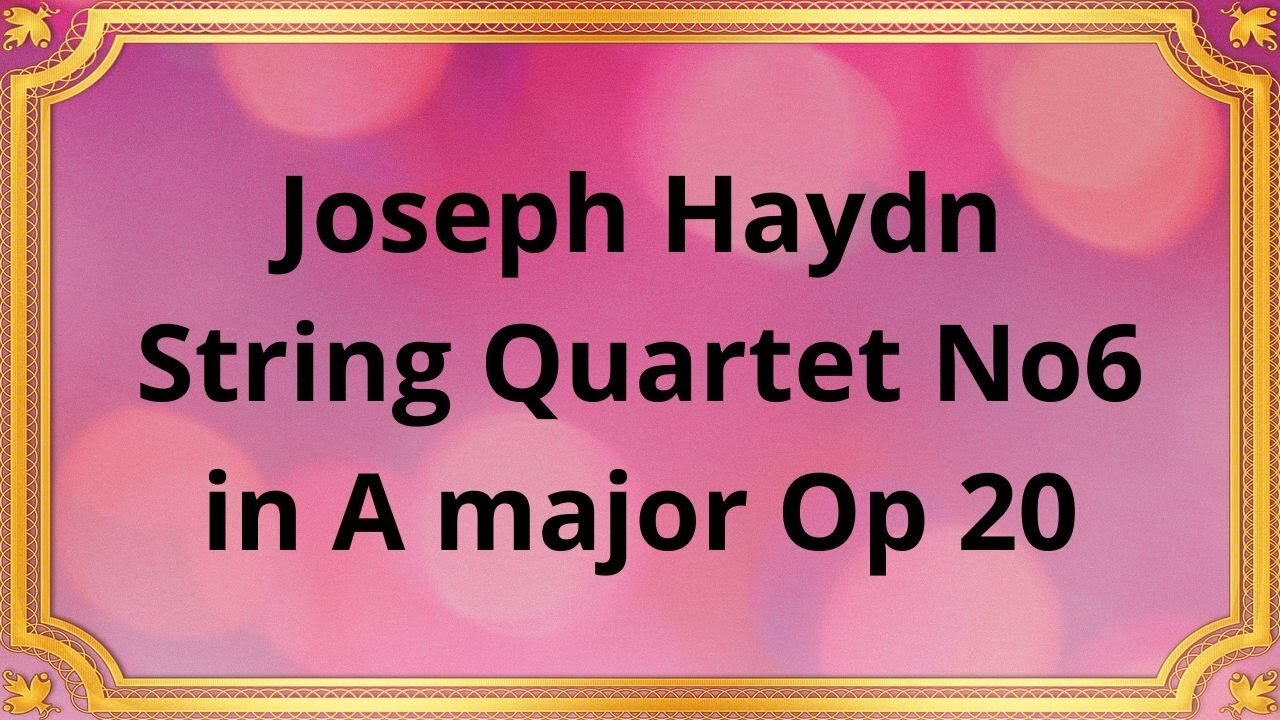Premium Only Content

Joseph Haydn String Quartet No6 in A major Op 20
#JosephHaydn #StringQuartet #Amajor #Op20 #classicalmusic #musicalcomposition #SunQuartets #historicalcontext #musicalcharacteristics #emotionalresonance #innovativeform #influentialcomposer
JOSEPH HAYDN COMPLETE STRING QUARTETS OF OP20
"The Sun Quartets"
Publication date 1952
SCHNEIDER QUARTET
Alexander Schneider, First Violin
Isidore Cohen, Second Violin
Karen Tuttle, viola
Madeline Foley, violoncello
Within the vast realm of classical music, certain compositions shine as timeless gems, and the "Joseph Haydn String Quartet No. 6 in A major, Op. 20" is undoubtedly one of them.
Composed in 1772, Joseph Haydn's String Quartet No. 6 in A major, Op. 20 is part of a set of six quartets known as the "Sun Quartets." These quartets were dedicated to Haydn's patron, Prince Nikolaus Esterházy, and they represent a significant milestone in Haydn's career. With this collection, Haydn pushed the boundaries of the string quartet genre, introducing innovative ideas and techniques that would influence generations of composers.
Haydn's String Quartet No. 6 in A major is a mesmerizing four-movement composition that showcases the composer's ingenuity and craftsmanship. The opening movement, marked Allegro di molto, bursts forth with exuberance and vitality. The quartet engages in a lively conversation, intertwining melodic lines and harmonies to create a rich tapestry of sound. Haydn's use of dynamic contrasts and rhythmic interplay adds depth and intrigue to this movement.
The second movement, marked Menuetto, presents a contrasting mood with its graceful and elegant character. This movement unfolds as a delightful dance, with Haydn's intricate melodies and rhythmic patterns captivating the listener's imagination. The quartet's seamless transitions and seamless unity of expression further enhance the enchanting atmosphere.
The third movement, marked Adagio, transports the listener to a realm of introspection and emotional depth. Haydn's gift for writing beautiful and expressive melodies is evident in this movement, as the quartet weaves a tapestry of profound beauty and contemplation. The quartet's nuanced phrasing and delicate interplay create an atmosphere of introspection and intimacy, evoking a range of emotions within the listener.
The final movement, marked Allegro, brings the quartet to a triumphant and exhilarating conclusion. It is a display of technical virtuosity, featuring rapid passages, intricate counterpoint, and vibrant harmonies. Haydn's mastery of form and structure shines through as the quartet navigates through moments of tension and resolution, building to a thrilling climax.
"Joseph Haydn String Quartet No. 6 in A major, Op. 20" is renowned for its ability to evoke a wide range of emotions within the listener. From the joyous and energetic moments to the introspective and contemplative passages, Haydn's composition strikes a chord with its emotional depth and resonance. The quartet's ability to captivate and move the listener is a testament to Haydn's profound understanding of human emotions and his skill in translating them into musical language.
Conclusion:
In conclusion, "Joseph Haydn String Quartet No. 6 in A major, Op. 20" is a testament to Haydn's genius as a composer. Its historical significance, musical characteristics, and emotional resonance make it a cherished work in the world of classical music. This quartet continues to captivate audiences with its innovative ideas, masterful craftsmanship, and ability to evoke profound emotions. Haydn's ability to push the boundaries of musical expression and create a harmonious tapestry of sound is a testament to his enduring legacy as one of the most influential composers in history.
You have the opportunity to support the channel:
https://destream.net/live/RadSiarAl/donate
https://www.buymeacoffee.com/6355radsiaral
-
 15:12
15:12
Classical music_Music Inspiration
1 month agoRalph Vaughan Williams, "Fantasy on a Theme by Thomas Tallis"
1161 -
 LIVE
LIVE
Lofi Girl
2 years agoSynthwave Radio 🌌 - beats to chill/game to
190 watching -
 31:30
31:30
The Why Files
7 days agoCodex Gigas | The Devil's Bible and the Nazi Hole to Hell
173K80 -
 1:05:26
1:05:26
Man in America
17 hours ago“Poseidon” Doomsday Sub, Microplastics & The War on Testosterone w/ Kim Bright
92.8K7 -
 1:05:57
1:05:57
Sarah Westall
10 hours agoThe Story the DOJ, the FBI and the Media doesn’t want you to Know w/ Christina Bobb
42.5K10 -
 2:16:01
2:16:01
IsaiahLCarter
1 day ago $16.58 earnedGraham Linehan: A Mess of Courage and Conviction || APOSTATE RADIO 034
34.6K -
 2:03:29
2:03:29
Tundra Tactical
11 hours ago $15.65 earned🛑LIVE NOW!! Honest Gun Company Slogans Gun Mad Libs and Much More
34.2K2 -
 4:54:33
4:54:33
MattMorseTV
11 hours ago $290.75 earned🔴Senate VOTES to END the SHUTDOWN.🔴
168K220 -
 2:55:39
2:55:39
Barry Cunningham
1 day agoBREAKING NEWS: DID PRESIDENT TRUMP MAKE A HUGE MISTAKE? SOME SUPPORTERS THINK SO!
66.1K42 -
 7:50:44
7:50:44
SpartakusLIVE
10 hours agoSOLOS on WZ || #1 Challenge MASTER is BACK in Verdansk
57.4K3